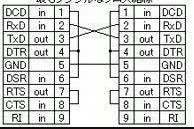Hi All,
I have a question about the TL16C550D.
When connecting with UART only by transmitter, connect not used CDC/DSR/RI pin to GND or Open?
And RTS to CTS short circuit. Is it OK?
When connecting to RS232C, the following connections were made.
- Short circuit RTS and CTS
- Short circuitDTR and DSR with DCD
- RI is open
Is it possible to process the pin in the same way as this?
Best Regards,
Ishiwata


